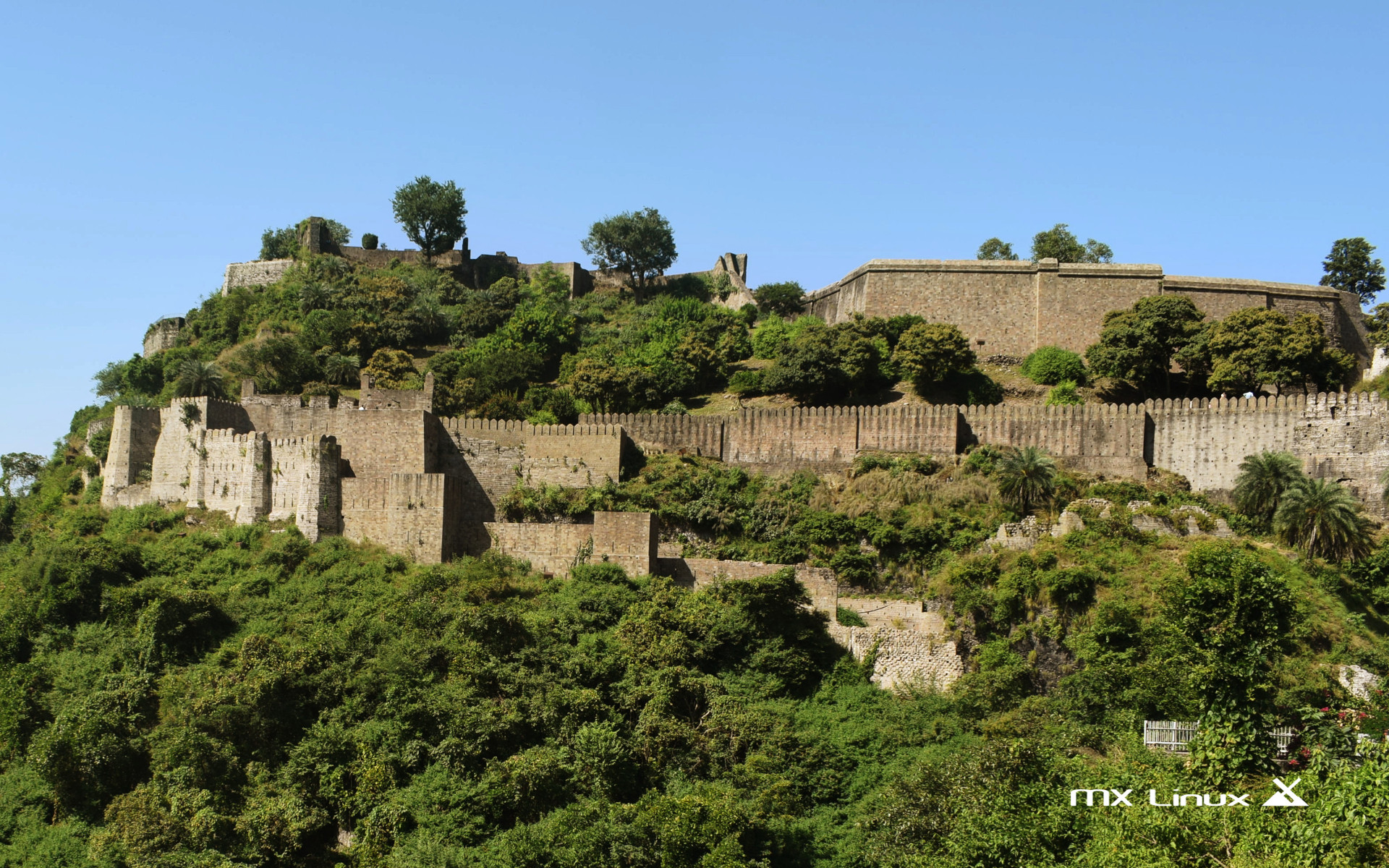
Nestled amidst the picturesque Himalayan ranges in the Kangra Valley of Himachal Pradesh, India, stands a majestic monument that has withstood the test of time – the Kangra Fort. This ancient fortress, steeped in history and surrounded by breathtaking landscapes, holds within its walls tales of valour, conquests, and resilience. Join us on an immersive journey as we unravel the mysteries and delve deeper into the rich heritage of Kangra Fort.
History and Origins:
The origins of Kangra Fort date back over 3,000 years, making it one of the oldest and largest forts in the Himalayas. The Katoch dynasty originally built it, and they ruled the region for centuries. Legend has it that Bhuma Chand, the first ruler of the dynasty, founded the fort atop a hill for its strategic advantages in defense. Over the years, the fort underwent several expansions and renovations, reflecting the architectural influences of various ruling dynasties, including the Mauryas, Guptas, and the Mughals.
Architecture and Design:
Spread across an area of approximately 4 square kilometres, Kangra Fort boasts a formidable structure built primarily of stone and clay. Its strategic location atop a hill offers commanding views of the surrounding valleys and rivers, making it an impregnable fortress in its prime. The fort is comprised of several gates, palaces, temples, and courtyards, each reflecting the diverse cultural influences that have shaped its architecture over the centuries.
The main entrance to the fort is through the Ranjit Singh Gate, named after Maharaja Ranjit Singh, who annexed the fort into his empire in the early 19th century. Upon entering, visitors are greeted by the magnificent Darbar Hall, a spacious courtyard flanked by ornate pillars and intricate carvings. The architectural style of the fort reflects a blend of Hindu, Mughal, and British influences, showcasing the evolution of design over different epochs of history.
Legends and Folklore:
Kangra Fort is not just a monument of stone and mortar; it is a repository of legends and folklore that have been passed down through generations. One such legend is that of Rani Padmini, the queen of Kangra, who chose self-immolation over surrendering to the invading forces of Mahmud of Ghazni in the 11th century. Her act of bravery and sacrifice continues to inspire awe and reverence among visitors to the fort.
Another legend associated with Kangra Fort is that of Jayachand’s Daughter, who is said to haunt the fort to this day. According to folklore, Jayachand, a chieftain, built the fort and sacrificed his daughter to ensure its protection from enemies. It is believed that her spirit still roams the corridors of the fort, seeking redemption for her untimely demise.
Conquests and Battles:
The history of Kangra Fort is marked by numerous battles and conquests, as it changed hands multiple times between rival kingdoms and empires. Its strategic location made it a coveted prize for ambitious rulers seeking to establish dominance in the region. The fort’s walls bear witness to the bloodshed and struggles endured by those who fought to defend it against invaders.
One of the most significant sieges in the history of Kangra Fort was led by Mahmud of Ghazni in 1009 AD. The siege lasted for more than a year, during which the defenders valiantly resisted Mahmud’s forces but were eventually overwhelmed by the sheer size and strength of the enemy army. Despite the defeat, Kangra Fort remained a symbol of defiance against foreign aggression, inspiring future generations to uphold the spirit of resistance.
Cultural Significance:
Beyond its military significance, Kangra Fort is also a cultural hub, showcasing the rich heritage of the Kangra Valley. The fort houses several temples dedicated to Hindu deities, including Ambika Devi, a form of Goddess Durga, whose shrine attracts devotees from far and wide. Additionally, the fort’s architecture and artwork serve as a testament to the artistic prowess of the craftsmen who adorned its walls with intricate carvings and frescoes.
The Kangra School of Art, which thrived in the region during the 18th and 19th centuries, gained renown for its miniature paintings depicting scenes from Hindu mythology and the daily lives of the people. These paintings, known for their vibrant colors and meticulous attention to detail, have earned international acclaim and continue to be celebrated as masterpieces of Indian art.
Preservation Efforts:
Despite its enduring resilience, Kangra Fort has suffered damage over the centuries due to natural disasters and human conflict. In recent years, stakeholders have made concerted efforts to preserve and protect this architectural marvel for future generations. They’ve undertaken conservation projects and restoration work to safeguard the fort’s heritage, ensuring it remains a symbol of pride for the people of Himachal Pradesh.
The Archaeological Survey of India (ASI), collaborating with local authorities and heritage conservation organizations, actively preserves Kangra Fort. They undertake measures like structural repairs, waterproofing, and documentation of historical artifacts to mitigate the effects of weathering and decay. Additionally, they implement initiatives to promote sustainable tourism and raise awareness about the significance of cultural heritage, ensuring the long-term preservation of Kangra Fort.
Influence of Buddhism:
During the reign of the Mauryan Empire, Kangra Fort served as an important center for Buddhist teachings and philosophy. Builders constructed monasteries and stupas within the fort complex, attracting pilgrims and scholars from far and wide. The remnants of these Buddhist structures serve as a reminder of Kangra Fort’s role in the spread of Buddhism in the region.
Architectural Features:
The architectural features of Kangra Fort are a testament to the ingenuity and craftsmanship of ancient builders. The builders designed the fort’s defensive structures, including ramparts, bastions, and watchtowers, to withstand enemy attacks and provide strategic advantage to the defenders. The intricate carvings adorning the walls depict scenes from Hindu mythology, royal court life, and everyday activities, offering valuable insights into the cultural and social milieu of the time.
Influence of British Rule:
With the decline of the Mughal Empire in the 18th century, Kangra Fort came under the control of the Sikh Empire and later the British East India Company. The British made several modifications to the fort, including the construction of barracks, artillery emplacements, and storage facilities, to strengthen its defensive capabilities. Kangra Fort served as a key military outpost for the British during the colonial period, playing a significant role in maintaining control over the Himalayan region.
Ecological Importance:
In addition to its historical and cultural significance, Kangra Fort is also an important ecological hotspot, supporting a diverse range of flora and fauna. The surrounding forests are home to numerous species of plants and animals, including rare Himalayan herbs, leopards, and Himalayan black bears.
Efforts to promote eco-tourism in the area have opened up opportunities for visitors to explore the natural beauty and biodiversity of the Kangra Valley.
Festivals and Events:
Throughout the year, Kangra Fort hosts a variety of festivals and events that celebrate the region’s rich cultural heritage. The annual Kangra Fort Festival showcases traditional music, dance, and art forms, attracting artists and performers from across the country.
Furthermore, the fort hosts religious festivals such as Navratri and Shivratri with great fervor, thereby attracting pilgrims and devotees who seek blessings from the deities enshrined within its walls. Moreover, these festivals add to the vibrant cultural tapestry of Kangra Fort, creating an atmosphere of spirituality and celebration. Additionally, they provide a unique opportunity for visitors to immerse themselves in the rich religious traditions of the region. Furthermore, attending these festivals allows visitors to experience the local customs and rituals firsthand, deepening their understanding of the cultural significance of Kangra Fort.
Tourism and Visitor Experience:
Kangra Fort is a popular tourist destination, attracting thousands of visitors each year from India and abroad. Guided tours are available for visitors to explore the fort’s various attractions, including temples, palaces, and museums. Additionally, adventure enthusiasts can embark on trekking expeditions to nearby mountain peaks, thereby offering panoramic views of the Himalayan landscape. Furthermore, local artisans and craftsmen also showcase their traditional skills at the fort, thereby offering visitors the opportunity to purchase handmade souvenirs and artifacts. Moreover, these activities enhance the overall experience of exploring Kangra Fort and its surroundings.
Future Prospects:
As India continues to emerge as a global tourist destination, moreover, Kangra Fort holds immense potential for further development and promotion. Investments in infrastructure, hospitality, and tourism services can enhance the visitor experience and generate sustainable economic opportunities for the local community. By leveraging its rich cultural heritage and natural beauty, Kangra Fort can become a flagship destination that attracts travelers seeking authentic cultural experiences and adventures in the Himalayas.
Conclusion:
In conclusion, Kangra Fort is not just a historical monument; it is a living testament to the resilience, creativity, and cultural diversity of the Kangra Valley. Moreover, its towering ramparts and timeless allure continue to captivate the imagination of visitors. Additionally, offering a glimpse into the glorious past and promising future of this iconic landmark. Besides, as we embark on this journey through time, let us celebrate the enduring legacy of Kangra Fort. Furthermore, let us pledge to preserve it for generations to come. Its towering ramparts and timeless allure continue to captivate the imagination of visitors, offering a glimpse into the glorious past and promising future of this iconic landmark. As we embark on this journey through time, let us celebrate the enduring legacy of Kangra Fort and pledge to preserve it for generations to come.
For More Articles Click






